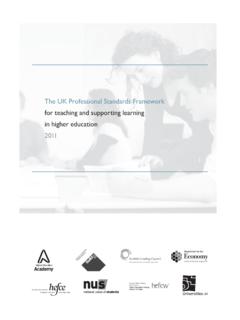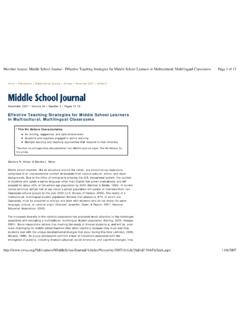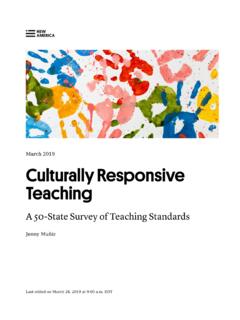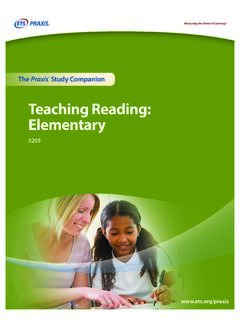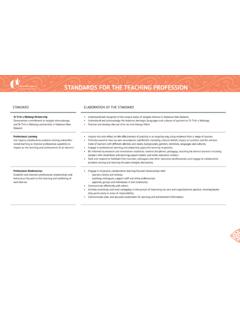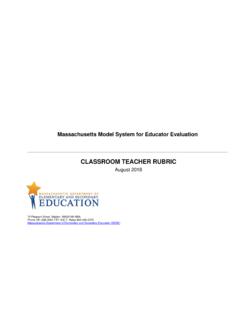Transcription of Independent learning - Higher Education Academy
1 Independent learning The information on these pages has been developed as part of the Teaching International Students project 2 Contents Section Page 1. Introduction 3 2. The main issues: getting started 3 What is Independent learning ? 3 Differences across disciplines 3 Differences across cultures 4 What are the challenges in encouraging more Independent learning ? 4 3. Possible solutions: suggestions for action 5 Setting the foundations for Independent learning 5 Ongoing support evidence suggests that effective and inspiring teachers: 5 Tools for Independent learning and self-organisation include: 6 Conclusions 6 4. Useful resources to recommend to students 6 5. What is the evidence? 6 6. Related resources 7 1. Introduction Many students have trouble making the transition to the more Independent learning required at university compared with their previous study.
2 University study requires students to take responsibility for their own learning , to be more self-directed, to make decisions about what they will focus on and how much time they will spend on learning both inside and outside the classroom. This transition may be especially difficult for international students who may be used to more support and direction and even parent-like relationships with their teachers at university. It will be useful for them (and all students) to know precisely how they are responsible for their learning in their new setting. This will require them to understand that they need to play a more active role in their own learning and will require greater self-motivation and organisation and greater self-awareness (metacognition) of their learning needs and behaviours. 2. The main issues: getting started What is Independent learning ?
3 As is the case with many terms commonly used in Higher Education learning , such as critical thinking , Independent learning can mean different things to different people, in different disciplines and in different cultures. Therefore, it is important that this pivotal concept is explained to students so that they know what is required of them within their new context and discipline. Philip Candy, in the now classic text Self-direction for lifelong learning (1991), quotes Forster (1972) to define Independent learning / study: 1 Independent study is a process, a method and a philosophy of Education : in which a student acquires knowledge by his or her own efforts and develops the ability for inquiry and critical evaluation; 2 it includes freedom of choice in determining those objectives, within the limits of a given project or program and with the aid of a faculty adviser; 3 it requires freedom of process to carry out the objectives; 4 it places increased educational responsibility on the student for the achieving of objectives and for the value of the goals.
4 This definition clearly places the responsibility for learning in Higher Education on students, aided by teaching staff and defined by the limits and objectives of the programme. Differences across disciplines Many international students may be surprised at how much work they are required to do on their own outside of class and, in the absence of specific direction, may not be aware of their own responsibilities. They sometimes complain about the lack of direction generally in their courses. They may be surprised by the low contact hours in many courses, especially in the Humanities and Social Sciences. They may even interpret this as a lack of value for money or a lack of interest and support from teachers or their department. It can be useful to spell out in course documents how many hours of work outside of the classroom are expected for each module or unit, and what precisely students are expected to do during this time.
5 Contact hours and the level of autonomy required (or possible) vary considerably across discipline areas. In the Sciences, for example, there is often less scope to choose assignment or research topics, and students 4 may be required to work on tasks and topics set for them right up to doctoral level, where students work in teams under the explicit direction of their supervisor. In the Humanities and Social Sciences, however, there can be much more autonomy in choosing learning and assignment tasks and topics even from the first year of study. Differences across cultures The extent to which Independent learning is culturally situated has been hotly debated in the literature. Some describe learners from particular cultures as passive and dependent learners (discussed in Kingston & Forland, 2008). Conversely, others are more positive, such as in a study on self-directed learning by Gieve and Clark (2005) in which Chinese students expressed as much appreciation of the benefits of autonomous learning as their EU counterparts.
6 Interestingly, the current system-wide reform of Education in China has as its top priority the development of autonomous learners (which is perhaps a more accurate term to use) and is clearly an indication of the importance placed on this attribute for effective learning . It is important, however, to avoid making assumptions about individual students, especially where their home contexts are diverse and undergoing rapid change. International students are likely to be unsure about what is required in their new learning contexts and may at least initially seem to want to know the correct methods and answers during this period of uncertainty, but they may be perfectly capable of independence and autonomy. The apparently culturally determined dispositions of students in Gieve and Clark s study were found to be flexible in the right (new) conditions.
7 This resource will explore what these right conditions might be; looking at the actions practitioners might take to enhance students Independent learning . What are the challenges in encouraging more Independent learning ? This story from a colleague working in China illustrates some of the misunderstandings (in this case, linguistic) around the concept of Independent learning : ' Independent learning ' was translated differently on a poster in a school I visited in China. They had borrowed our list of 'good learning behaviours' but had translated Independent learning as ' learning on your own and not distracting or talking to others around you'. This point reinforces the need to be explicit about what precisely students are expected to do and achieve. Most adult learning theory ( Freire, 1972; Knowles, 1990; Mezirow, 1991) and the concept of Independent learning itself should be acknowledged as being predominantly Western.
8 Trahar (2007) gives a personal and academic account of the implications of this on teaching in an international landscape including the potential for a lack of sensitivity to diversity, cultural inviolability and false universalism. Recognising this and using Forster s (1972) definition of Independent learning , it can be seen quite broadly to encompass a variety of situations and contexts where students are interpreting and scaffolding new knowledge and skills independently from those around them. However, this may include situations of group learning where activity may be collaborative and individual learning outcomes similar (or different) but each reached independently. Considered in this light, Independent learning does not need to be seen only in terms of learning in isolation but also within a community of learners. Certainly, Independent learning is a term used frequently in Higher Education : Here, they (lecturers) all the time emphasise self- learning and self-directed learning .
9 But how can we learn when there is no direction at all? (International student quoted in Welikala & Watkins, 2008). 5 Here, we see how this concept, if not introduced and exemplified can be seen as confusing. No doubt, students accepted on to Higher Education courses are already successful learners (Forland, 2006) but in order to expand learners existing strategies to new contexts mutual effort is required from all participants to learn about and appreciate alternative approaches to learning (Jin & Cortazzi, 2006). The following sections identify some strategies practitioners have described as useful in their practice. 3. Possible solutions: suggestions for action Setting the foundations for Independent learning Talk to your students about their previous learning and teaching experiences. Find out their expectations of the course how are they expecting to be taught, assessed and how do they expect to facilitate their own learning .
10 Talk about your expectations (as a teacher, organiser and facilitator) and the requirements of the course Reach a shared understanding of these expectations (see sections on lectures, supervision). Talk about Independent learning in the context of communities of learners and provide opportunities for developing study communities (through group work, tutor-organised study buddies, online discussion boards). The transition for students into new ways of learning can be supported by providing early formative assessment and plenty of opportunities for students to explore their learning with peers and teachers. Ongoing support evidence suggests that effective and inspiring teachers: Take time to develop a meta-awareness of other cultures (Ryan & Louie, 2007). Give an overview of the subject matter so that learners have a framework within which to build their knowledge.


